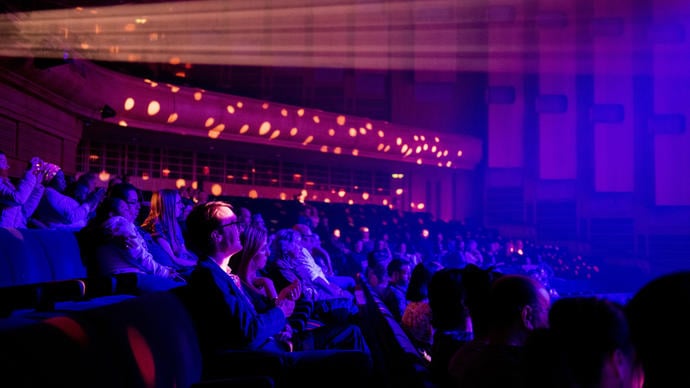A person walks on stage holding a handful of wood, four strings and some horsehair, tasked with filling a cavernous hall and 90 minutes, all alone. For most of us, this is an anxiety dream – but not for Nicola Benedetti. ‘It’s hypnotic,’ she says, ‘a focused, trance-like feeling.’
There are artistic benefits to playing solo, rather than with colleagues, too: ‘You’re on your own, with no one to answer to other than the composer. There is a different level of freedom in what you can do, and how you interpret the music and occupy the space. You don’t have to make any decisions that you’ll be held to, such as speeding up here or slowing down there. There’s no one to consult or consider so your interpretation can change more wildly.’
The solitude demands a special type of communication, she explains: ‘The challenge is to create intimacy in a large hall. Are you able to capture everyone and pull them into your space? There’s a vulnerability to being alone on stage, but when you shed your protective veil, it’s the most direct relationship you can have with an audience. There’s an element of magic when any player or group performs, but when it’s a solo recital, with one person creating all those layers from one mind, people become very engrossed.’
It’s no surprise, therefore, that composers and violinists alike have been inspired to write for the form, and that solo violin works are some of the finest in the instrument’s repertoire. The three that Benedetti has chosen for this recital span four centuries in the violin’s development, offering historic snapshots of its sound in the 18th, 20th and 21st centuries.
Johann Sebastian Bach’s (1683–1750) Six Violin Sonatas and Partitas were written by 1720, the date inscribed on its exquisitely penned autograph manuscript. Not much is known about who they were written for and how they were played during his lifetime. Bach himself must have been a fine violinist and they take the instrument’s technical, musical and spiritual potential far beyond anything that had yet been written. They were only published in 1802, 52 years after his death, but now they are staples of a violinist’s repertoire.
The D minor Sonata is one of the more frequently played, best known for its last movement, the monumental Chaconne, which is often performed on its own. Benedetti is in no doubt why: ‘The Bach Chaconne is the greatest work ever written for violin. It’s endlessly interesting and reveals new things every time you play it, so it’s never the same twice. Over the centuries it has generated a huge amount of intrigue, fascination and analysis. When you play it, you’re telling the story of something that has its own life and power.’
Belgian Eugène Ysaÿe (1858–1931) was the leading violinist of his generation, known for his phenomenal technique and beautiful tone. He was a fine interpreter of Bach’s Sonatas and Partitas himself, but it was hearing Joseph Szigeti performing the G minor Sonata that inspired him in 1923 to write his own set of six sonatas as an attempt to demonstrate how far the violin sound had come since Bach’s time. His sonatas therefore contain both fiendish technical demands, but also relatively new sound worlds.
The Fifth Sonata in particular focuses less on fireworks and more on the violin’s tonal range. Benedetti explains: ‘The techniques Ysaÿe chooses for the Fifth Sonata are unique among the six. All of them are written so well for the violin, but the Fifth is more experimental – it has more sweetness and warmth. In the first movement the thematic material is slow and melodic. The second movement is a dance with an awkward rhythmic structure, which moves into more ethereal sounds. The dance material then returns in two different time signatures and builds and builds until the end.’
The five movements of Wynton Marsalis’s (b 1961) Fiddle Dance Suite, of which Benedetti gave the world premiere in 2015, push the violin’s sound world even further, incorporating ragtime, bebop, Spirituals and blues as well as the reels, Strathspeys and hoedown of Benedetti’s native Scotland. She explains, ‘It mixes
different musical traditions in its harmonies and rhythmic diversity. There are many surprises and quirks, using forms that everyone relates to, but those conventions are pulled apart. For example, with the first movement, the ‘Sidestep Reel’, I give the misimpression at the beginning that you could tap your foot to what I’m playing, but very quickly, that becomes impossible!'
What does she want audiences to take away from the recital? She says: ‘I’d like them to experience the diversity and complexity of the instrument and its capabilities, and to step with me into its world, expecting and wanting to hear different sounds, rather than just a continuous, predictable sound.’ The sound world of this concert is certain to be anything but predictable.
© Ariane Todes


